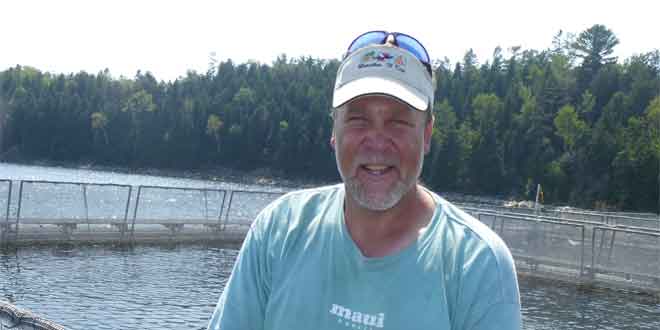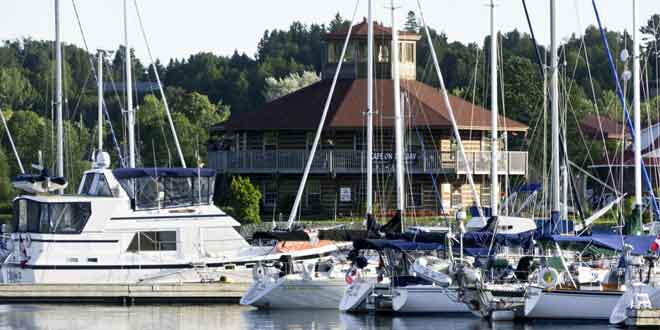BURNT ISLAND—Even though beef operations for Blue Goose Pure Foods is winding down, aquaculture, or fish farming, is continuing to thrive and expand on Manitoulin Island.
“Aquaculture is one hundred percent secure, we’re excited to see fish farming grow,” Mike Meeker of Meeker’s Aquaculture, a division of Blue Goose Pure Foods, said. “Ned Goodman, the owner, is happy to see what’s going on.”
Meeker’s Aquaculture began rejuvenating the existing Burnt Island fish hatchery on the Purvis property to start growing rainbow trout fingerlings for cage farming last November.
“The first 70,000 fingerlings we receive will be the first organic fingerlings in Canada,” Mr. Meeker said.
Rainbow trout fingerlings need to be large enough (at least 50 grams) to thrive in the cages. With the decline of rainbow trout fingerlings of the right size available from southern Ontario, according to Mr. Meeker, the next best thing is to purchase fingerlings at around five grams and grow them in a facility within closer proximity to the Blue Goose cage sites, improving efficiency.
Before the first batch of fingerlings arrive, the 34 foot diameter rings need to be filled with a dependable water supply which comes from three separate well pumps and one deep lake pump. But the beauty of the entire system is the recirculation well. The recirculation well collects all of the drain water from the rings and raceways and filters it through separate chambers, allowing the fish waste to settle (to be collected for compost) so the water can be pumped back to the fish, full of oxygen and free of ammonia and excess nitrogen. The more water is recycled the less water is drawn from the other wells and Lake Huron. The two pumps operating the recirculation well from the German based company Wilo are designed for submersible pump applications and to provide a high output of flow with low pressure.
Water quality is the main issue. When growing fingerlings the temperature, the amount of oxygen, nitrogen and ammonia are some of the elements to be monitored closely. For example, the dissolved oxygen meter will tell you how much oxygen is available to the fingerlings. If the meter is showing low oxygen, the tanks have two carry pumps attached, recirculating the water in the tank and splashing it around, creating more oxygen.
Considering the power outages Manitoulin Island receives, a back-up power supply isn’t a bad idea. A generator is on site to power the entire system, and if someone isn’t there, an automatic transfer switch turns the generator on and shuts it off and switches back to hydro when the power turns back on. If it is an extended power outage, and the generator happens to run out of fuel, a secondary back-up diesel vertical turbine pump can operate the recirculation well to keep water flowing and oxygenated until the power can be restored. An auto dialer machine will be installed to notify Mr. Meeker of any problems day or night.
The fish will be fed mainly with automatic feeders. A feeder will gradually feed the fish throughout the day. Hand feeding will be done mainly to check if the fish are still hungry or the feeder needs to be shut off.
Safety is also a priority. Walkways are being constructed with handrails and the moving parts of pumps and motors are sealed.
According to Meeker’s Aquaculture, phase one of the project will be completed once the site is operational and the four rings have fingerlings growing. Phase two will be to get the 15 concrete raceways operational to allow for a capacity of approximately 2 million fingerlings.
Burnt Island is home to Purvis Fisheries and its dockside processing plant, which also processes a percentage of Blue Goose-farmed rainbow trout.





